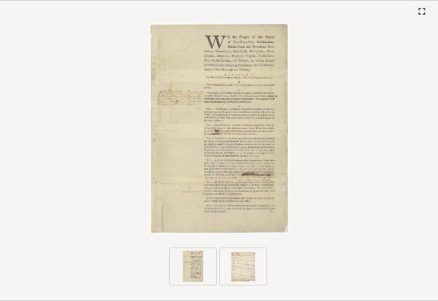We the People

Published By:
Historical Era:
Thinking Skill:
Bloom’s Taxonomy:
Grade Level:
Suggested Teaching Instructions
This activity can be used to introduce the Constitution and the concept of self-government. It would also be appropriate during a unit on the Constitutional Convention and the ratification process. For grades 6-12.
Before beginning activity, review with students that when drafting the Constitution, the delegates established a Committee of Detail that was tasked with preparing a draft of a Constitution that reflected the resolutions that had been approved as of July 23,1787. The members of the committee included John Rutledge (SC), Nathaniel Gorham (MA), Oliver Ellsworth (CT), Edmund Randolph (VA) and James Wilson (PA). The earlier preamble (the printed document on the left) contained the names of each state listed individually.
In September, the delegates appointed a final committee, the Committee of Style, to “revise the stile [sic] of and arrange the articles which have been agreed to by the House.” The committee was comprised of Chairman William Samuel Johnson (CT), Alexander Hamilton (NY), James Madison (VA), Rufus King (MA), and Gouverneur Morris (PA). This included changing the language of the final preamble (engrossed document on the right) included in the ratified US Constitution.
While students examine the documents, ask them to consider the following questions:
- What is the difference between the Preamble of the draft and the final version?
- What is the significance of changing the wording?
- Why do you think the delegates assigned to the Committee of Style changed the opening of the Preamble?
- Once the Constitution was sent the states for ratification, what objections may they have to the changes made from the original draft to the final version?
Once the students have responded to the questions, hold a class discussion based on their answers.
After students share their responses to the first two questions, inform with students that the first major change involved opening the preamble with the words, “We the People of the United States,” rather than listing each state individually. The second change lengthened the Preamble, which explained the document’s intention to establish a new government and articulated the purposes of the new government.
On September 15, 1787, the delegates ordered that the final draft be engrossed on parchment, and on September 17th, 39 delegates signed the Constitution and sent it to Congress for approval before being sent to the states for ratification.
After discussing the fourth question, share with students that once the Constitution reached the states, there was immediate reaction to the Preamble. Patrick Henry (Va.), asked during the ratifying convention in Richmond, “Who authorized them to speak the language of ‘We the People’…instead of “We the States’? States are the characteristics and the soul of a confederation…The people gave them no power to use their name.”
After completing the activity, direct students to the “When You’re Done” button and ask them to respond to the question:
- Imagine you are a delegate sent to the Constitutional Convention. Which Preamble would you have supported? Why?
Students can see a full transcript of the final ratified Constitution by clicking “View Primary Source Details,” scrolling down and clicking “Transcript.”
Information about the Constitutional Convention and ratification process excerpted from: Potter, L., Eder, L.K., (2009). George Washington’s printed draft of the constitution and Mike Wilkins’s preamble. Social Education, 73(4), 156-160.
Description
In this activity, students will examine the original and final drafts of the Constitution and evaluate the significance of the selection of the words “We the People.”
Share this activity with your students
Documents in this Activity

George Washington's Annotated Copy of a Draft of the U.S. Constitution